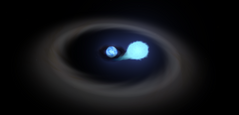Astronomy:HD 326823
| Observation data Epoch J2000.0 Equinox (celestial coordinates) | |
|---|---|
| Constellation | Scorpius |
| Right ascension | 17h 06m 53.9045s[2] |
| Declination | −42° 36′ 39.704″[2] |
| Apparent magnitude (V) | 9.03[3] |
| Characteristics | |
| Spectral type | WNpec[4] |
| U−B color index | -0.19[3] |
| B−V color index | 0.84[3] |
| Astrometry | |
| Proper motion (μ) | RA: +2.545[2] mas/yr Dec.: −2.251[2] mas/yr |
| Parallax (π) | 0.6919 ± 0.0193[2] mas |
| Distance | 1,270[5] pc |
| Orbit[6] | |
| Period (P) | 6.1228 days |
| Eccentricity (e) | 0.17 |
| Inclination (i) | 45° |
| Argument of periastron (ω) (secondary) | 197±14° |
| Semi-amplitude (K1) (primary) | 230±12.7 km/s |
| Details | |
| WN | |
| Mass | 5.5[6] M☉ |
| Radius | 19.51[lower-alpha 1] R☉ |
| Luminosity | 80,000[5] L☉ |
| Temperature | 22,000[5] K |
| O | |
| Mass | 29.1[6] M☉ |
| Radius | 10[6] R☉ |
| Other designations | |
V1104 Scorpii, 2MASS J17065390-4236397 | |
| Database references | |
| SIMBAD | data |
HD 326823, also known as V1104 Scorpii, is a binary star containing a unique emission-line star, which is in the midst of transitioning to a nitrogen-rich Wolf-Rayet star, as well as being a candidate Luminous blue variable, located 4,142 light years away in the constellation of Scorpius. The primary is very evolved, because it is composed of almost entirely helium, and only 3% of it is still hydrogen,[4] and it has lost most of its mass to the now-very-massive secondary. The underlying mechanisms and mass transfers in the system are comparable to other W Serpentis systems, such as Beta Lyrae and RY Scuti.[4]
Properties
Assuming a distance of 1.27 kiloparsecs, the primary has a temperature of 22,000 K and a luminosity of around 80,000 L☉ (~104.9 L☉). This corresponds to a radius about 19.5 R☉.[5] Older analyses included a higher luminosity of 200,000 L☉, and a distance of 2 kpc. The primary star's stellar wind has a very low terminal velocity of just 200 kilometres per second and through that wind is losing 5.2×10−6 M☉ (about 10−5.28 M☉) per year.[4] The primary's mass is around 5.5 M☉, and its initial mass may have been about 25 M☉.[6]
Not much is known about the secondary, except for its mass of 29.1 M☉, a significant part of which may be from the primary. Assuming it is a main sequence star, it may have a radius of 10 R☉.[6]
Orbit
The primary and the secondary orbit each other every 6.123 days. The orbit has an eccentricity of about 0.17, and is inclined at about 45 degrees. The argument of periapsis is about 197 degrees.[6]
Environment and evolution
The visible star (the primary) is a mass donor, and is transferring mass to the unseen secondary, which is enshrouded in a thick accretion torus. As a result, only the primary (mass donor) is observed. Mass loss occurring at both the L2 and L3 points suggests a large circumbinary disk, which is the source of stationary emission lines in the spectrum. The complex light curve is probably due to the tidal distortion of the primary, as well as variations in the thickness of the torus.[6]
The visible star in HD 326823 has been stripped of its outer layers by the secondary star. If this continues, the system may evolve into a system similar to Gamma Velorum, where the mass donor is now a hydrogen-stripped Wolf-Rayet star, that is orbiting a more massive O-type star, formerly the secondary.
Hydrogen-deficient donor stars in W Ser-esque binaries, such as the primary in HD 326823, will likely explode in Type Ib/c supernovae, after they evolve into Wolf-Rayet stars, and understanding the pre-SN evolution of these stars is critical to the interpretation and modeling of the supernovae they produce.[6]
Notes
- ↑ Applying the Stefan–Boltzmann law with a nominal solar effective temperature of 5,772 K:
- [math]\displaystyle{ \sqrt{(5772/22000)^4 * 80,000} = 19.51\ R\odot }[/math]
References
- ↑ "ASAS-SN Variable Stars Database". ASAS-SN. https://asas-sn.osu.edu/variables/lookup.
- ↑ 2.0 2.1 2.2 2.3 2.4 Brown, A. G. A. (2021). "Gaia Early Data Release 3: Summary of the contents and survey properties". Astronomy & Astrophysics 649: A1. doi:10.1051/0004-6361/202039657. Bibcode: 2021A&A...649A...1G. Gaia EDR3 record for this source at VizieR.
- ↑ 3.0 3.1 3.2 Ducati, J. R. (2002). "VizieR Online Data Catalog: Catalogue of Stellar Photometry in Johnson's 11-color system.". VizieR Online Data Catalog 2237. Bibcode: 2002yCat.2237....0D.
- ↑ 4.0 4.1 4.2 4.3 Marcolino, W. L. F.; de Araújo, F. X.; Lorenz-Martins, S.; Fernandes, M. Borges (2007-02-01). "Spectral Analysis of the Pre-WN Candidate HD 326823". The Astronomical Journal 133 (2): 489–495. doi:10.1086/510242. ISSN 0004-6256. Bibcode: 2007AJ....133..489M.
- ↑ 5.0 5.1 5.2 5.3 Smith, Nathan; Aghakhanloo, Mojgan; Murphy, Jeremiah W.; Drout, Maria R.; Stassun, Keivan G.; Groh, Jose H. (2019-09-01). "On the Gaia DR2 distances for Galactic luminous blue variables". Monthly Notices of the Royal Astronomical Society 488 (2): 1760–1778. doi:10.1093/mnras/stz1712. ISSN 0035-8711. Bibcode: 2019MNRAS.488.1760S.
- ↑ 6.0 6.1 6.2 6.3 6.4 6.5 6.6 6.7 6.8 Richardson, N. D.; Gies, D. R.; Williams, S. J. (2011-12-01). "A Binary Orbit for the Massive, Evolved Star HDE 326823, a WR+O System Progenitor". The Astronomical Journal 142 (6): 201. doi:10.1088/0004-6256/142/6/201. ISSN 0004-6256. Bibcode: 2011AJ....142..201R.
 |



